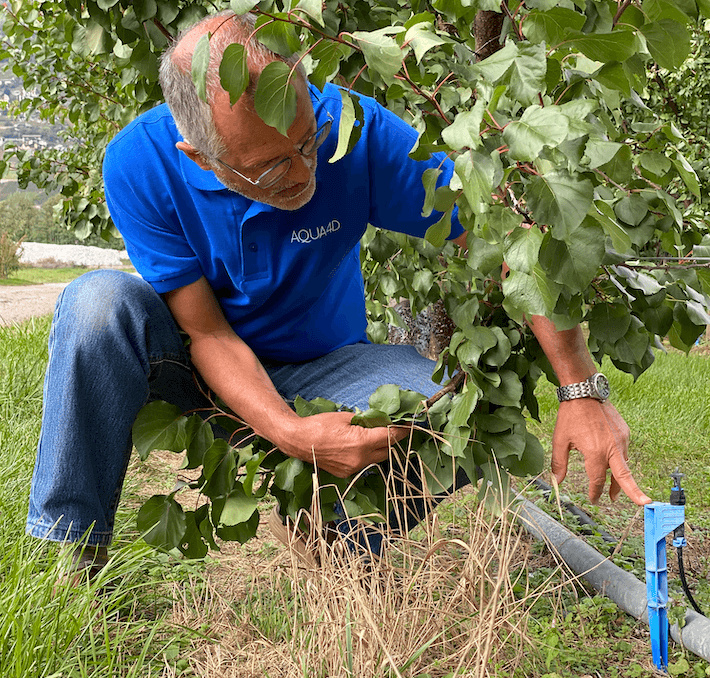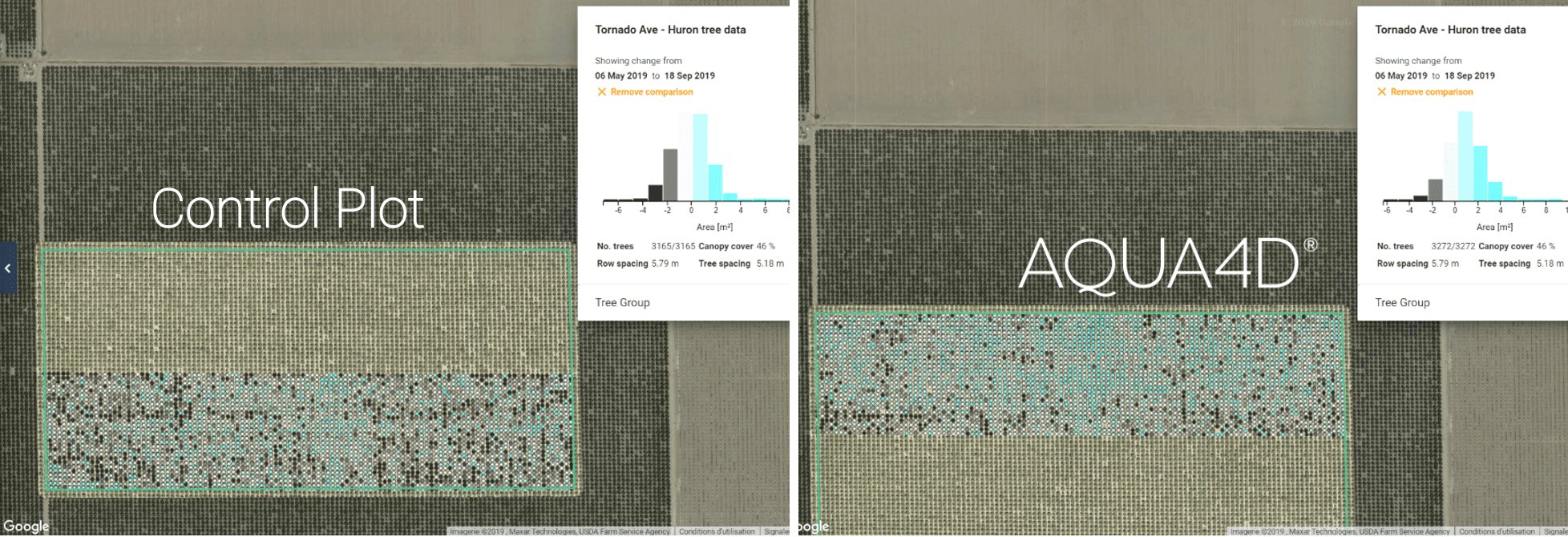At AQUA4D, we are much more than just providers of precision irrigation hardware. Our mission is to create long-term value, working together with our clients to create the maximum positive impact. A crucial part of this is a deep commitment to Agriculture 4.0 principles, integrating advanced technologies in farming practices to increase efficiencies and meet the food production demands of the future.
Measuring everything is at the center of what we do at AQUA4D® – quantifying and adjusting is integral to the service we provide and maximizing the impacts of our technology. Indeed, our mantra is “If you cannot measure it, you cannot manage it”. These measurements are necessary so that clients can adapt their practices to the changes our tech brings and achieve the best results all round. As US agronomist Jeff Nunes states, “AQUA4D® is a game-changing technology, so the people utilizing it have to change their game in turn”.
Innovative monitoring
To do so, we apply a range of partner technologies with regular follow-ups, including Tensiometers (soil water tension), AquaSpy (soil moisture probes), 2Grow (sap flow and stem diameter sensors) and Aerobotics (drone imaging).
The exact use of these is determined by the team of AQUA4D® field specialists. Before a project kick-off, they define the issue(s) faced by the grower and gain a full understanding of their needs and how AQUA4D® can help.
These issues run the gamut of irrigation management aspects, including dealing with water scarcity, soil degradation, salinity, and mineral or organic clogging. Although we deep-dive into specific issues, we never lose sight of the bigger picture. This is because AQUA4D® can have a cascade of impacts – oftentimes even by focusing on solving one specific problem, other aspects of the plants and soil will be impacted in turn, and thus need to be monitored too.
Paradigm shift
Combining our innovative tech with precise measurements can enable a paradigm shift in irrigation practices. With escalating droughts – and with water metering coming in places like California – increased efficiencies ultimately save both resources and money. In one example, instead of a grower irrigating for 10-15 hours straight, real-time monitoring determined the exact timing and dose of irrigation required, given that AQUA4D® treatment meant soils were staying moist for much longer.
It can sometimes be challenging to change established practices, but seeing the resources saved, growers are increasingly convinced of the need to optimize their operations. As Jeff Nunes says: “AQUA4D® will help growers save resources, save money, and save their farm; it is no longer a good idea, but a necessity.”
Essentially, AQUA4D® is an innovative piece of irrigation hardware, but it is the agronomical service that goes along with it that adds exponential value. Let’s take a look at some of the Ag 4.0 tech which our team uses to measure and adjust irrigation practices to achieve impressive results.
 : Measuring sap flow and stem diameter
: Measuring sap flow and stem diameter
2Grow is a Belgian company providing a real-time image of plant growth, measuring sap flow, stem diameter and plant stress. With AQUA4D®, this has led to some interesting results in greenhouse growing conditions in North America and Europe.
A study in the Netherlands found that AQUA4D® led to greater daily diameter growth, meaning the plants had to use less of their internal reserves and suggesting that AQUA4D® makes water more available to the plant roots. 2Grow also observed measured less daily stem variation in plants treated by AQUA4D® : treated plants experienced less stress as they did not need to work harder. Finally, 2Grow also found that AQUA4D® treated plants were able to recover much faster from night-time losses. To this end, 2Grow’s expert Olivier Begerem, who was involved in the study, explains: “This energy surplus goes towards the fruits instead of growth and this results in higher yields.” (find out more in this article)
 : Measuring soil moisture & EC
: Measuring soil moisture & EC
Another technology frequently used with AQUA4D® clients is AquaSpy probes. These 120cm long rods are inserted vertically into the soil and have sensors at 10cm intervals that detect soil moisture, measure soil electroconductivity (EC), and temperature at each depth. This helps calculate the plant’s active root area and ideal moisture range. For AQUA4D® specifically, it demonstrates increased soil moisture, and is hence useful in determining the ideal irrigation dose and schedule given the changes in the soil properties brought about by our tech. Adjusting this is crucial to prevent over- or under-irrigating a crop.
AquaSpy also provides us with a real-time indication of where salts are being pushed, helping monitor the effects AQUA4D® is having on soil salinity – a huge issue in many areas. For example, in the coastal areas of northern Peru an avocado grower was able to leach salts below the rhizosphere and hence prevent them from crystalizing around the root area. The grower was able to decrease irrigation volumes by 10% due to more effective lixiviation – enabling better nutrient uptake and less water required to obtain an equally effective leaching effect (more info on this case here).
In this avocado project, the graph below shows soil electroconductivity (EC) at depths of 20 to 40 cm using AquaSpy probes, clearly demonstrating how salts are gradually being moved below the rhizosphere as a result of AQUA4D® treatment:
 : An aerial overview
: An aerial overview
Aerobotics uses a combination of satellite imagery, high-resolution drone imagery, and machine learning to provide farmers with crop data. Exact data for every single tree can be measured, including health, chlorophyll content, canopy cover, height, and volume of a tree over time. This technology enables farmers to track trees, detect those that are unhealthy, and act decisively where needed to increase efficiency and yield.
In one of several California projects, Aerobotics was used to compare two almond tree plots in the Central Valley. The results were unequivocal that AQUA4D®, seen on the bottom, led to healthier trees. This is denoted by more blue dots than the control plot. “AQUA4D has positively impacted on our irrigation cycles,” says one Central Valley almond grower. “There are completely different dynamics going on out there.”
Tensiometers: measuring soil water tension
Tensiometers are a simple way of measuring soil water tension and indicating the soil-water conditions experienced by the plants’ roots – and whether the plant is experiencing stress or if it is being drowned.
For a bell pepper producer in Spain, tensiometers were used effectively to monitor the increased soil moisture brought about by AQUA4D®. Below, the first graph demonstrates that the AQUA4D- irrigated plot had 31% more soil moisture on average over the studied period than the control. The second graph shows how the grower adapted their irrigation times so as to not drown the plant because of this increased moisture. Ultimately, AQUA4D® combined with tensiometer measurement enabled the grower 20% water savings.
Conclusion
Technology can go a long way to solving some of the most pressing issues faced in agriculture. But as is often the case, when human ingenuity combines with innovative tech, we can start to make a real difference. AQUA4D® is a fine illustration of this, bringing about exponential benefits and resource savings when combined with the latest Ag 4.0 tools. As 2Grow’s Olivier Begerem states, “Measuring is knowing: it’s time to stop assuming and start measuring.”
Read more: Real-time Plant Measurements and Optimized Irrigation
View more:
Richard Gemperle on the AQUA4D impact in his Californian orchards
Flourishing hemp plants in California with water-smart precision irrigation
Worldwide
Water-Smart Agriculture
Precision Irrigation






